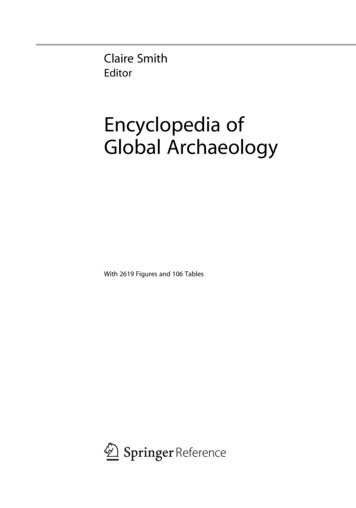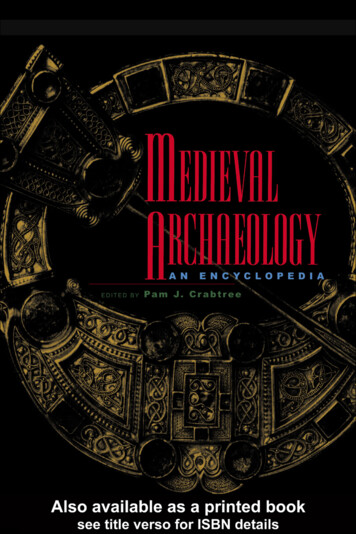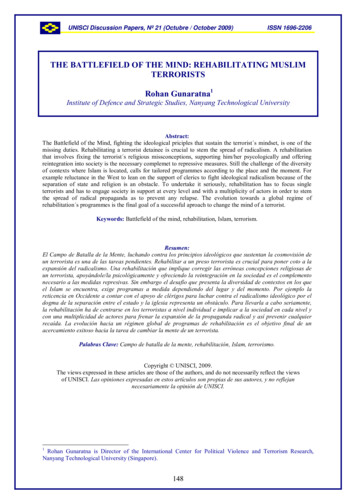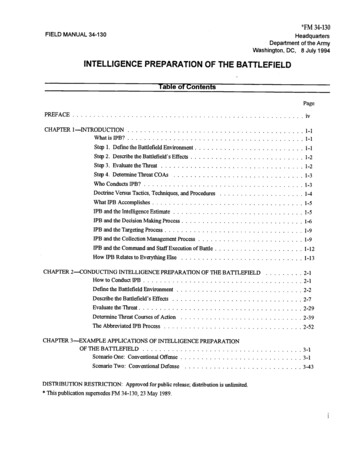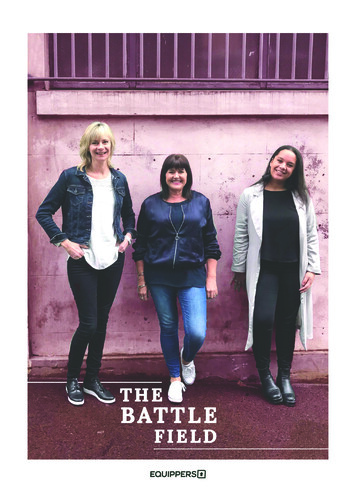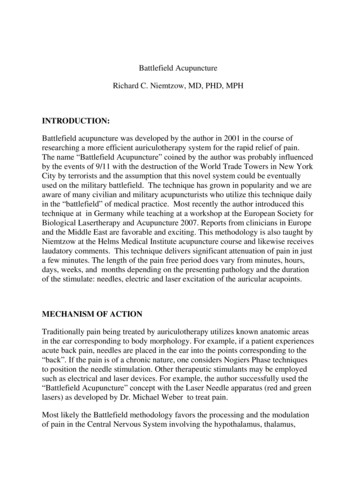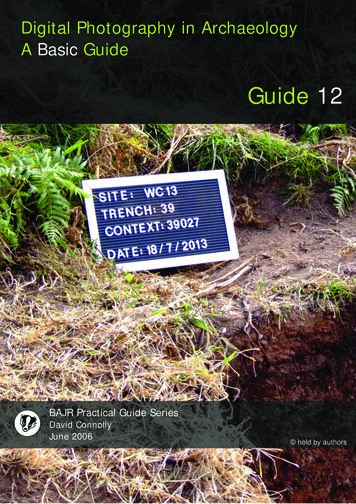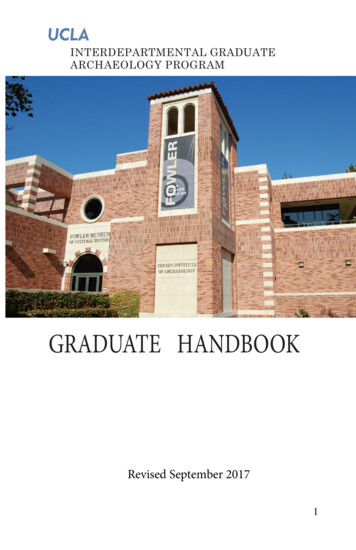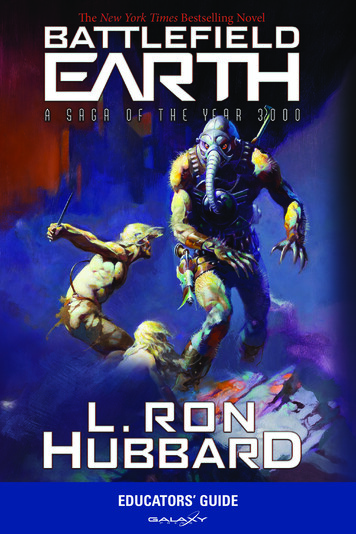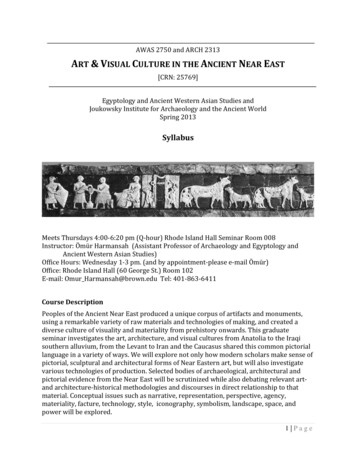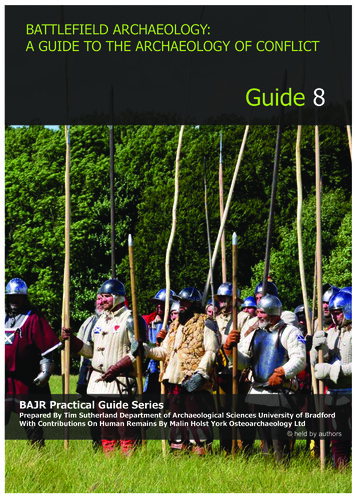
Transcription
BATTLEFIELD ARCHAEOLOGY:A GUIDE TO THE ARCHAEOLOGY OF CONFLICTGuide 8BAJR Practical Guide SeriesPrepared By Tim Sutherland Department of Archaeological Sciences University of BradfordWith Contributions On Human Remains By Malin Holst York Osteoarchaeology Ltd held by authors
TABLE OF ON12.0WHAT IS BATTLEFIELD ARCHAEOLOGY?13.0WHY IS THE ANALYSIS OF SITES OF CONFLICT IMPORTANT?33.1THE USE OF CONFLICTS FOR PROPAGANDA AND MISINFORMATION43.2BATTLEFIELDS AS MEMORIALS53.3BATTLEFIELD TOURISM73.4RE-ENACTMENT83.5FOCI FOR SOCIAL ACTIVITIES83.6VIEWS OF THE NATIONAL BODIES93.6.1The Battlefield Trust93.6.2English Heritage93.7BATTLEFIELDS AND THE MEDIA104.0A BRIEF BATTLEFIELD HISTORY114.1INTRODUCTION114.2CASE STUDIES134.2.1Pre-Twentieth Century Archaeological Investigations135.0WHY MIGHT A SITE OF CONFLICT BE DISTURBED145.1WHAT LEGISLATIONBATTLEFIELDS?5.1.1English ern Ireland186.0IDENTIFICATION OF SITES OF CONFLICT18ISTHEREINPLACETOPROTECTHISTORIC 15
6.1EVIDENCE FOR CONFLICT186.2HOW LARGE MIGHT A BATTLEFIELD BE196.3DIFFERENT TYPES OF BATTLEFIELD SITES197.0METHODS OF EVALUATION207.1EARTHWORK SURVEYS217.2GEOPHYSICAL SURVEY217.2.1Metal Detector Survey217.2.2Fluxgate Gradiometer or Magnetometer227.2.3Electrical Earth Resistance Meter237.2.4Ground Penetrating Radar (GPR)237.3FIELD WALKING237.4DESK TOP ASSESSMENTS238.0ARTEFACT IDENTIFICATION AND BATTLEFIELD SIGNATURE248.1INTRODUCTION248.1.1The Impact of Local Geology on Artefact Preservation248.1.2Excavation of Artefacts248.2THE SIGNATURE OF A SITE OF CONFLICT258.3A LACK OF ARTEFACTS: AN IMPORTANT NOTE268.4ARTEFACT DENSITY278.5MAPPING ARTEFACT LOCATIONS279.0HUMAN REMAINS FROM SITES OF CONFLICT289.1THE IMPORTANCE OF HUMAN REMAINS FROM SITES OF CONFLICT289.2POSSIBLE CIRCUMSTANCES OF SKELETAL DISCOVERY289.2.1Mass Graves299.2.2Exposure on the Battlefield299.2.3Human Remains in Pits299.2.4Other Burial Contexts299.3LEGISLATION REGARDING HUMAN REMAINS309.3.1English Law309.3.2Scottish Law309.3.3Welsh Law309.4EXCAVATION OF HUMAN REMAINS FROM SITES OF CONFLICT31
10.0TOWTON: AN EXAMPLE OF THE SUCCESSFUL ARCHAEOLOGICALANALYSIS OF A BRITISH MEDIEVAL .3Concise Methodology3611.0FUTURE latesExperts from the Royal Armouries, Leeds analyse some of the fifteenth century artefactsrecovered as part of the Towton Battlefield Archaeological SurveyA modern British military button recovered from the medieval battlefield at Azincourt,France as part of the archaeological survey13The memorial cross on the battlefield at Azincourt, France64Chickamauga Battlefield Visitor Centre, Tennessee, USA75A re-enactment, in Britain, of a battle from the American Civil War86Blast damage and bullet holes (some repaired) on the 19th /early 20th century victorymonument in BerlinBlast damage and bullet holes (some repaired) on the 19th /early 20th century victorymonument in Berlin128A Roman military 'mask' or helmet faceguard from the Varus Battlefield, Germany139The skull of Skeleton 9 from the 1996 Towton mass grave1410Battleflats Way, on the site of the 1066 Battle of Stamford Bridge, Yorkshire, which hasbeen destroyed due to a housing development1411Signage close to the Chickamauga Battlefield Visitor Centre, Tennessee, USA2212Medieval arrowheads discovered during the Towton Battlefield Archaeological Survey2213Musket ball and Second World War bullet recorded on the Agincourt battlefield2614Musket ball and Second World War bullet recorded on the Agincourt battlefield2615A small number of the recorded artefacts from the battlefield at Towton, Yorkshire2616Recording the location of an artefact found during a metal detecting survey, with a GPS, as 27part of the Towton Battlefield Archaeological Survey127Figures212
12The location of Towton Hall, and the Towton battlefield, which lies between the villages 18of Towton and SaxtonIllustration of the contents of the 1996 Towton mass grave as it would have appeared prior 32to excavationTables1Summary of weapons technology by period2AppendicesAThe Register Of Historic BattlefieldsIBVICPlanning Policy Guidance No 15 Dated September 1994 Which Gives StatutoryGuidelines For Planning IssuesBattlefields: The Proposed Register Of Historic BattlefieldsDEnglish Heritage News Release, 7 April 2004XIIEThe Hansard Report Of The Exchanges In The House Of LordsXIVFGuidelines Regarding The Disturbance Of Human RemainsXVIGIFA Conference 2004 - Battlefield Archaeology Session, Organised by Dr.P. FreemanFurther InformationXVIIHVIIXIX
AcknowledgementsThe authors would particularly like to thank Simon Richardson, whose perseverance and enthusiasm led to therecovery of numerous artefacts that helped to archaeologically identify the Battle of Towton. Gratitude shouldbe expressed to the landowners of those battlefields investigated, who have permitted access to their land. Weare grateful to Dr. Arnold Aspinall for his helpful advice and comments. We would also like to thank DavidConnolly, who encouraged the production of this document, which will hopefully aid all of those dealing withthe archaeology of battlefields.
BAJRBattleGuide1.01INTRODUCTIONThis document contains a series of guidelines which are intended to assist a variety of individuals, fromdevelopment control officers, land managers, prospective developers, archaeologists, to metal detectorists andother interested parties in assessing the impact of potential work on sites of historic battles or conflicts.Wherever possible, examples have been given in order to illustrate each concept. This document containsinformation and a series of proposals, which, if acted upon, will increase the potential evidence that can beacquired from a field of conflict.This document is not written as a manual of how to carry out battlefield archaeology, but simply as a guide tothe understanding of the discipline and the procedures that should be put in place if such sites are to beinvestigated or potentially disturbed. However, a case study from the Towton Battlefield Archaeological SurveyProject is included so that an impression can be gained as to how such a project has developed.Although many sites of conflict, which relate to standing structures and earthworks, for example Britain’s fortsand castles, have been archaeologically excavated, this cannot be said of the sites of other engagements, such asbattles. Consequently, it is only very recently that this aspect of military history has been substantiated usingarchaeological investigation (see Section 4).The problem with many sites of conflicts is that actual remains of the event, the obvious physical heritage,rarely survive above ground. If archaeological evidence cannot be seen, it is less likely to be recorded andprotected, as ‘popular’ heritage sites are generally those where the remains of the ‘site’ can be viewed. Thisfailing is plainly exhibited in English Heritage’s‘Conservation Bulletin of the Historic Environment’(Dorn 2003, 7), entitled The Archaeology ofConflict. Of the 64 pages devoted to the topic, onlyone eighth of one page is devoted to battlefieldsthemselves, that is, to the sites where conflictactually took place. The remainder of that documentdiscusses Britain’s defensive sites, prisoner of warcamps, cold war bunkers and airfields etc. Very fewof these topics cover the physical remains of actualconflict. This example illustrates the problemsassociated with the archaeology of battlefields – theyare rarely discussed because of their apparentlyvague and ephemeral nature. However, the contraryis true: battlefields are repositories of a vast amountof significant and virtually untapped historicalinformation (Plate 1).2.0Plate 1 Experts from the Royal Armouries, Leeds analysesome of the fifteenth century artefacts recovered as part ofthe Towton Battlefield Archaeological Survey( T.L.Sutherland 2004)WHAT IS BATTLEFIELD ARCHAEOLOGY?Battlefield Archaeology is an all-encompassing term that is popularly given to the discipline of the archaeologyBattlefield ArchaeologySutherland & Holst
BAJRBattleGuide2of ancient or historical conflict. The term ‘battlefield archaeology’ is slightly misleading, as the subjectgenerally focuses on the archaeology of the event, such as the battle, rather than the field on which it took place.The term ‘the archaeology of battle’ is therefore often used as a more precise description of the discipline.However, the archaeology of battle should, in reality, be incorporated into one of the aims of a ‘battlefieldproject’ as it is virtually impossible not to encounter the archaeological remains of other periods or events whilstthe project is being carried out.Needless to say, in such cases, as with any otherarchaeological investigation, all of the recoveredPlate 2 A modern British military button recoveredfrom the medieval battlefield at Azincourt, Franceas part of the archaeological surveyevidence should be recorded and not simply ignoredbecause it does not comprise part of the evidence ofthe conflict under examination (Plate 2). Furthermore,it is often not known if a piece of recovered evidenceis related to the conflict in question until additionalevidence has been gathered and patterns begin to formwithin the data. What might initially be considered tobe an irrelevant piece of information might later turnout to be unique data related to the conflict underinvestigation. For instance, it is believed that the firstprojectile shot from a handgun in a conflict was firedduring the medieval period. However, it is not clearwhat form this projectile took - it might have been astone ball, an arrow, or fragments of metal - and as aresult, this undoubtedly important object might not berecognised upon discovery.( T.L.Sutherland 2004)The principles applied to battlefield archaeology might also be used to investigate historical periods of civilunrest. For example, during the ‘Peterloo Massacre’ in early nineteenth century Manchester, many civilianswere killed. Although this was partly a civil conflict, which took place in an urban environment, rather than amilitary battle, archaeological evidence in the form of the skeletal trauma would be expected if the skeletalremains of the combatants were discovered. Such evidence could be used to confirm or dispute the historicalrecords of the event. The term, the ‘archaeology of conflict’, rather than ‘battlefield archaeology’, is therefore amore appropriate general expression.In a modern context the archaeology of conflict manifests itself all too graphically in the mass graves of thosevictims of oppression discovered in Iraq following the second gulf war in 2002. In this respect, there is, sadly,all too much continuity between these remains and those found in mass graves from prehistory. For example, anumber of individuals who had been attacked and killed using stone axes in c.5000BC were recovered from aNeolithic mass grave in Talheim, Germany (Wahl and König, 1987). Although the weapons might havechanged, the final results of each conflict are uncomfortably similar.The archaeological recording of remains of historical or ancient conflict is therefore not unlike that ofarchaeological practice in a modern forensic context; the only difference being the preservation of the evidenceand the time frame in which the events took place. An important difference, however, is that if more than 75Battlefield ArchaeologySutherland & Holst
BAJRBattleGuide3years have elapsed since the conflict took place, it is unlikely that anyone will be brought to justice to accountfor the events that are under investigation (Pollard 1996).3.0WHY IS THE ANALYSIS OF SITES OF CONFLICT IMPORTANT?The most simple and possibly the most important reason for the study of the archaeology of conflict is that onlyby searching for evidence of such an event can a close approximation be obtained of exactly what took place ona particular site. This is confirmed by Dyer (1985), who suggests that ‘battlefields provide a unique opportunityto study the material by-products of human conflict’. This analysis needs to be carried out systematically andconsistently, and in order to do this methodically, the artefactual residue of both factions need to be analysedleaving aside the propaganda and the over-glorification of the narrative. In this respect Gould's statement ishelpful when he suggests that ‘artefacts are signatures of particular kinds of behaviour and that consequentlybehaviour can be identified if the signatures’ relationships are studied’ (Gould 1983, 105).How this archaeological evidence is studied and more importantly, how it is interpreted, is of the greatestimportance. It can and should be distinguished from the historical literary evidence, which is usually based onpersonal accounts of the event and is not always necessarily reliable. Few, if any of those at a scene of conflict,can give an accurate account of the entire event, as sites of conflict are by their very nature traumatic andconfusing places. They also often cover large areas of ground. The observer might not even have known howlarge the conflict was, or how many casualties were taken on another part of the field. The larger picture of theconflict therefore depends upon a general overview and this was usually supplied by one of the leaders of onefaction. Apart from the bias inherent in such a view, it also relies upon an interpretation of the event, rather thanan objective account.In order to gain a more accurate understanding of the event, such as its scale or the number of dead, an accountshould ideally be obtained from something or someone who would not provide, or profit from, a distortedversion of it - someone who would provide a neutral viewpoint. Although on a practical level this could be doneby analysing the residue - the concentrations of artefacts left on the ground after the conflict - on a personallevel, this is an almost impossible task, as the notion of conflict is often distorted by an inability to distanceoneself from most of its forms.Possibly the most graphic description of the results of combat, and a personal perspective on how one mightprevent future conflicts, was provided by Technical Sergeant Donald Haguall of the 48th Quartermaster GravesRegistration Unit in the second World War. Although disturbingly graphic, this descriptive account is given bysomeone who dealt with the results of conflict on a day-to-day basis. It is therefore a first-hand account of whatit is like to observe the contemporary remains of a field of conflict.‘Sure, there were lots of bodies we never identified. You know what a direct hit by a shell does to a guy. Or amine, or a solid hit with a grenade, even. Sometimes all we have is a leg or a hunk of arm.The ones that stink the worst are the guys who got internal wounds and are dead about three weeks with theblood staying inside and rotting, and when you move the body the blood comes out of the nose and mouth. ThenBattlefield ArchaeologySutherland & Holst
BAJRBattleGuide4some of them bloat up in the sun, they bloat up so big that they bust the buttons and then they get blue and theskin peels. They don't all get blue, some of them get black.But they all stunk. There's only one stink and that's it. You never get used to it, either. As long as you live, younever get used to it. And after a while, the stink gets in your clothes and you can taste it in your mouth.You know what I think? I think maybe if every civilian in the world could smell this stink, then maybe wewouldn't have any more wars.’ (Purnell undated, 2688)In order to prevent the over-glorification of wars and conflict, it is therefore important, as Sergeant Hagualladvises, to get as close as possible to the residue of a conflict. Rather than ignoring the physical remains ofconflict, as has been the case for too long, they should be studied in order to find out more about the darker,uncomfortably unpleasant side of human nature. Reading about a 'glorious' battle in a history book is one thing;seeing the evidence of the same battle on the skeletal material in a mass war grave is something quite different.3.1THE USE OF CONFLICTS FOR PROPAGANDA AND MISINFORMATIONThe relevance of the remains of battle can be an emotive subject. They have often been used in an attempt topersuade people to take part in further conflicts. The St. Crispins Day speech in Shakespeare’s Henry V (Act 4,Scene 3; Wilson 1983) for example, is a fictitious version of an address used to rally the troops in Henry’s armyprior to the Battle of Agincourt (1415). In the speech, it was suggested that after the conflict with the French, thesoldiers could proudly show off those scars that they had received during the battle. The moral-boosting effectsof this speech are so effective that the speech or derivatives of it are still used today by troop leaders beforegoing into combat. Of course, they omit to mention that many of them would eventually also have to beconfronted by the horrors of war as described by Sergeant Donald Haguall above. The selective use ofinformation that is passed on to the soldiers, as propaganda, is typical during times of war.An element of caution must therefore be connected with the study of historical sources on the subject ofconflict, as the likelihood for its misuse and distortion of the facts for nationalist or propaganda purposes isgreat. The German National Socialist Workers Party in 1930’s Germany, for example, used the historicalversion of the German victory over the Romans at the Varus Battle (AD9) to promote their own ideology ofGermanic superiority. They were not concerned with the fact that the location of the site was unknown at thetime and that the actual evidence of the events at Varus lay undiscovered. Winston Churchill, on the other hand,used key words from Shakespeare’s Henry V to describe the overwhelming odds faced by the RAF during theBattle of Britain. They were, like Henry’s soldiers, to become ‘The Few’, echoing the earlier English strugglesagainst overwhelming odds at Agincourt in 1415.More recently, in the unstable former Yugoslavia of the late 1990’s, the Serbian President, Slobodan Milosevic,was accused of using the medieval defeat of the Serbians at Kosovo Polje (1389, Kosovo Plain; ‘Field of theBlack Birds’; Roberts 2003) to fuel Serbian ethnic hatred and to promote ethnic cleansing. The Serbs ‘endowed[the battle] with myths of honour and heroism that helped them preserve their dignity and sense of nationhood’(ibid). The anniversary of the battle on June 28, Vidovdan (St. Vitus's Day) is the Serbian national holiday. Aninternational court in The Hague is currently trying Milosevic in an attempt to find out if accusations of warcrimes inciting ethnic cleansing are true. Material used in this trial will rely not only upon personal testimoniesBattlefield ArchaeologySutherland & Holst
BAJRBattleGuide5but also upon archaeological evidence obtained by the forensic analysis of individual or mass graves of victimsof the conflict.However, having access to the archaeological evidence will not always produce the desired political results. Amass grave discovered in 1943 at Katyn Wood in Poland was used as propaganda by both the allies and axisfactions for their own purposes. This led to a crisis that could have divided the Russian, American and Britishallies at a crucial moment of the Second World War.‘In April 1943 German troops in occupied Russia claimed to have found a mass grave in which the bodies ofsome 4,500 Polish officers, once prisoners of the Russians, were buried. For the Axis propagandists this wasnaturally a major opportunity to be exploited, a chance to force a rift in the Allied front. And it succeeded well,for the Russians, confronted with the evidence, reacted with anger, and blamed the slaughter on the Germans.But their awkward handling and presentation of their case only succeeded in embarrassing their allies andincreasing everyone's suspicions. When the war ended, the whole question of responsibility was convenientlyshelved ’ (Jerrard Tickell, undated)This issue caused a huge rift in the Allied command, as the then Nazi German Government hoped it would. Itwas not until the late twentieth century that information was forthcoming which proved that Soviet troops hadbeen responsible for the slaughter (Haglund 2002).The examples above illustrate that propaganda, or a distortion of the truth connected with conflict isoften used to sway public opinion and it is therefore a potentially dangerous tool. If this information isnot challenged by actual physical evidence, ideally collected by an independent or neutral body, thenthose wishing to exploit it, as highlighted in the courtroom battle over the issue of Holocaust denial(Gibbons 2000), will attempt to perpetuate the myths or inaccuracies associated with these events.3.2BATTLEFIELDS AS MEMORIALSBattlefields, particularly modern examples, are often viewed as types of memorials. The actor and authority onthe medieval longbow, Robert Hardy (in Boardman 1996) suggests that‘A battlefield is a tomb, holding the bodies of most of those who died there ; a perpetual shrine and memorialwhich should engage our thought and our reverence’Many ex-servicemen and their relatives visit the grave sites of their lost relatives and comrades on or close tobattlefields around the world. The war cemeteries are mostly well-tended plots of land in tranquil settings,which befit their status as national memorials. The now famous lines of Rupert Brooke’s poem ‘The Soldier’,sum up the emotions and memories such sites evoke:‘If I should die, think only this of me;That there’s some corner of a foreign fieldThat is for ever England’ (Brooke in Jones 1998, 44)Battlefield ArchaeologySutherland & Holst
BAJRBattleGuide6If, however, the memorial itself is not on the battlefield, the focus can become detached from the site of theconflict. The connection between the battlefield and the memorial could later be lost, as the memorial itselfbecomes the symbol of the event. This highlights the need to physically record where the boundaries of conflictslie, as there are cases, such as the battle of Bosworth Field, Leicestershire, where the exact location of thebattlefield is uncertain and therefore its limits are unknown. On the battlefield of Agincourt, France (1415), thesite of the graves is seen as the focus of the battlefield (Plate 3), although there is contradictory evidence tosuggest that the battlefield might lie elsewhere (Sutherland, forthcoming 1).Currently, national bodies, such as the Commonwealth WarGraves Commission, tend and upkeep war cemeteries aroundthe world. The largest Commonwealth war cemetery at TyneCot in Belgium contains 11,908 graves (Keegan et al 1985,161). These are, however, memorials to the conflicts of therecent past. How long will it take until these battlefieldcemeteries, like so many others throughout history, will becomederelict and are then ploughed away or developed due to a lackof visitors who would recognise their former importance?Although such notions presently appear inconceivable, there arecurrently areas of land in north-west Europe which are knownto contain human remains from the First World War that aretreated with little respect.At the Battlefield Archaeology conference at the National ArmyMuseum in July 2003, a paper highlighted the work undertakenby forensic pathologists who attempted to identify the remainsof soldiers from the First World War found during developmentwork (Lewis 2003). The skeletal remains, some of which werealso identifiable, were given formal burial following their( T.L.Sutherland 2004)analysis. Another paper at the same conference, however,discussed the fact that personal identification plates, or ‘dog tags’, from soldiers lost on battlefields were beingremoved by some metal detectorists from skeletons and sold on the open market. This statement provoked ageneral feeling of revulsion from the audience with one delegate (Robertshaw 2003 pers. comm.) suggestingthat this act was ‘like killing them twice’. This is because it makes identification of bodies, subsequently foundon the battlefield by forensic anthropologists, all the more difficult. In fact, the threat of dying anonymouslyoften drove individuals to attempt to have their remains recognised in the event of their death. For example,before identification tags became generally available, some soldiers wrote their names on pieces of paper andattached them to their own uniforms (ibid). Although these paper fragments might not survive archaeologically,the recent advances in the analysis of DNA have led to the repatriation of some of these remains, in some casesclosing the book on what happened to loved ones after they died in battle.Plate 3The memorial cross on thebattlefield at Azincourt, FranceThese examples illustrate the sentiments surrounding the locations on battlefields of the bodies of known orunknown soldiers. The ultimate reflection of these feelings is exhibited by the numerous and often enormousstructures around the world that are known individually as ‘the tomb of the unknown soldier’. Such memorialsBattlefield ArchaeologySutherland & Holst
BAJRBattleGuide7recognise the deaths of those who have no known grave. It is, therefore, of the greatest importance to accuratelyrecord the locations of where the combatants from a conflict lie.The strength of feeling regarding war cemeteries, and the popularity of historic battlefields, particularly invokedby the media and the current trend to destroy sites of conflict, suggest that the general public support the studyof battlefields through their educational, financial and emotional involvement. Additionally, there is now aBritish ‘All Party War Graves and Battlefields Heritage Group’ based in the House of Lords, which discussessuch issues and how they might be rectified.3.3BATTLEFIELD TOURISMHistoric battlefields are often the foci ofeducational trips and recreational visits. Althoughthis potential has not yet been fully appreciated inBritain, visitor centres around the world attractlarge numbers of tourists (Plate 4).The conflict should not be overtly glorified in themuseum; on the contrary, the factual evidence ofthe actual conflict should illustrate the views ofboth factions as well as the sequence of events.This can be simply expressed in an educationalformat that is both informative and interesting.The sites of these visitor attractions alsorejuvenate an often rural local economy, andprovide individuals of all ages with a greaterunderstanding of a country’s, or a specific region’sformative periods in time.Plate 4 Chickamauga Battlefield Visitor Centre,Tennessee, USA ( T.L.Sutherland 2004)Visitor numbers of battlefield centres vary greatly across the world, from approximately 30,000 per year at thevisitor centre in the village of Azincourt, France, (Delcusse 2002 pers. comm.) to over 2,000,000 annually at theAmerican battlefield at Gettysburg, Virginia (Babits 2004 pers. comm.). The concept of the battlefield visitorcentre taps into the vein of heritage management, which not only exploits historical sites as a means of aidingtheir understanding and preservation, but also raises the profile of these important events.Organisations within the tourism and heritage industry also fully exploit the popularity of battlefields byorganising battlefield tours to a variety of sites around the world (Guardian, 1999). A specialist publication,‘Battlefields Review’ established in May 1999 (van Hasselt, 1999, 1), encouraged the reader to ‘explore thesites where history was made’. It states that ‘battlefield touring is now one of the world’s fastest growing leisureactivities’. However, if a battlefield is not a pleasant place to visit - such as a site that has been built over - thenit will be difficult for even keen visitors to imagine the scene of the battle and the site will not attract eithervisitors or the ever-increasing number of historical re-enactors. The site thus loses its historical and educationalvalue.Battlefield ArchaeologySutherland & Holst
BAJRBattleGuide3.48RE-ENACTMENTEach year major re-enactments, which are often attended by thousands of visitors, are staged at battlefield sitesaround the world (Plate 5).Anarticlein‘TheArchaeologist’, the Institute ofField Archaeologist’s ownjournal,enthusiasticallysuggests that‘ re-enactment events are apowerful way to bring historicsites to life. They can recreatepast lives, characters andPlate 5 A re-enactment, in Britain, of a battle from the American Civilevents, transporting the visitorWar ( T.L.Sutherland 2004)back to the court of Henry VIIIor the heat of the battle of Hastings. In short they bring us face to face with history English Heritage currentlystages more than 600 events at over 200 sites. The guiding principle is that events should derive inspirationfrom sites where they are staged.’ (Borman 2002, 22).The above quote highlights the English Heritage criteria of ‘conservation, integrity and accessibility’ (seebelow) for inclusion of a site of conflict into their Battlefield Register. The large number of visitors attracted tothese sites illustrates the current interest in battlefields despite the fact that often little physical remains can beviewed at the site of the conflict. Caution must always be applied to such events, however, as conflict shouldnever be viewed or understood simply as a form of entertainment. In archaeological terms, a historicallyaccurate re-enactment should never be allowed to take place on a historical site. The danger lies in the fact thatafter a replica lead shot, for example, has spent several years buried in the soil it is difficult to differentiate itfrom an original artefact. The quality of manufacture of replica artefacts is now so good that loosing them on ahistorical site can distort the gen
1 Experts from the Royal Armouries, Leeds analyse some of the fifteenth century artefacts recovered as part of the Towton Battlefield Archaeological Survey 1 2 A modern British military button recovered from the medieval battlefield at Azincourt, France as part of the archaeological survey 2 3 The memorial cross on the battlefield at Azincour.
